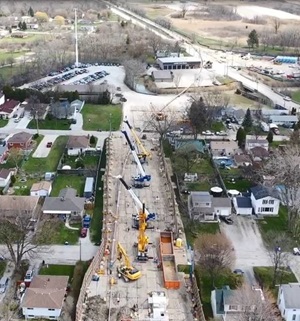Energizing Michigan since 1953.
New St. Clair River segment of Line 5 now in service
‘Textbook execution’ despite numerous obstacles; enhanced safety measures are built in
A new segment of Enbridge’s Line 5 pipeline—installed via horizontal directional drilling (HDD) under the St. Clair River between Ontario and Michigan—was placed into service on July 31, 2020.
The project makes a safe pipeline safer, and delivers on one of seven key actions in a 2017 agreement between Enbridge and the State of Michigan to address the future of Line 5, and protect the waters of the Great Lakes for future generations.
The project entailed replacement of the section of Line 5 crossing the St. Clair River at Marysville, MI. That section, which previously lay on the bed of the river, now crosses far below the riverbed with new, state-of-the-art line pipe.
The HDD process, which involves drilling an underground arched tunnel to house a pipeline, is generally used to install pipelines across large rivers or sensitive water crossings to minimize impact to landowners, residents and the environment.
The St. Clair River Horizontal Directional Drilling Project kicked off in February and was completed with an incident-free safety and environmental record. The 30-inch-diameter pipe segment runs between Sarnia, ON and Marysville, MI.
The project enjoyed “textbook execution,” says project manager Larry Smerechinski, who recently retired after 35 years with Enbridge, calls the work. “The quality is top-drawer, we had no safety incidents and we’ve met all regulatory conditions and commitments. On paper, you couldn’t really draw it up any better.”

Pipe on the Ontario side was moved into place through Sarnia, lined up at the entry point of the river, and pulled across to Marysville, MI
Project overcame multiple hurdles, including COVID-19
While this was a smaller project for Enbridge—with a workforce of about 90 people and a segment length of 2,814 feet (858 meters)— its timely completion represents a significant achievement considering the many factors at play, including:
- Crossing an international waterway, with different regulatory and environmental permitting requirements.
- Congested urban work areas at both ends, adding to the complexity of the HDD.
- Engaging nearby Indigenous communities, municipalities, homeowners and residents on both sides of the U.S.-Canada border.
- Use of measures such as noise curtains, vibration monitoring, periodic road closures and close coordination with local municipalities.
Add to that perhaps the biggest challenge of all—the emergence of the COVID-19 pandemic in early March.
“At the start of this, none of us even heard anything about COVID-19 and the impact it would have on us personally, as well as on the project,” says Smerechinski. “We immediately began following local health authorities’ recommendations. Extra precautions and protocols were developed by Enbridge, requiring an additional layer of diligence by everyone onsite.”
Adds Joel McKim, a senior construction specialist with Enbridge: “It started building up and all of a sudden it was full on. Since this was a cross-border project, I was back and forth to Michigan all the time at first. But that was soon halted, because if I came back I’d have to quarantine for 14 days.
We're doing everything we can to protect the health and safety of our employees and the public.
Says McKim: “COVID-19 definitely threw us a big curveball, but we stuck it out as a team and the crew became one big family. We got the pipe welded, tested up and pulled back and tied in with no hiccups. Now we’re ready to bring the pipe into service and we’re now focused on wrapping things up.”
Extra safety built into St. Clair segment
Enhanced safety features of the new pipe segment include heavier wall thickness (3/4-inch replacing 1/2 inch), and higher-tensile-strength steel.
The segment also has a fusion-bonded epoxy coating, with an abrasion-resistant overlay for added protection.
New, remotely operated valves feature continuous pressure monitoring on both sides of the river.
Additional technical challenge
Because of the congested area, a particular technical challenge was building of the horizontal segments 0.3 miles (0.5 km) from the hole where it would tunnel under the river.
“Usually when you do an HDD, you build the pipe as close as you can to where you’re going to be pulling it from—and in as straight a fashion as possible. With this one, we had to do a big ‘S’ bend and then build the pipe across a highway and a little creek, to get the pipe section in place to pull,” explains McKim.
“We drilled from both sides and intercepted it pretty much right at the border (at a depth of about 40 feet or 12.2 metres under the river) and then reamed out back and forth with both rigs at 42 inches in diameter and pulled from the west (Michigan) side. That was a feat in itself.”
(TOP PHOTO: Installation of higher-tensile-strength steel pipe under the St. Clair River.)
You may also like
Find out more about our operations in natural gas pipelines/LNG exports, liquids pipelines, gas utilities and renewable power.
Check out our interactive map encompassing the full scope of Enbridge's North American energy infrastructure—oil and gas pipelines, wind farms, solar projects, distribution systems, and more.








